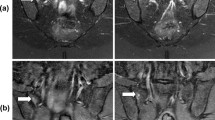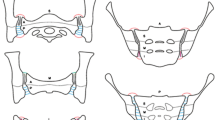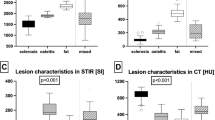Abstract
Objective
To compare short tau inversion-recovery (STIR) with another fat saturation method in the assessment of sacroiliac joint inflammation.
Methods
This prospective cross-sectional study comprised 76 spondyloarthritis (SpA) patients who underwent magnetic resonance imaging of the sacroiliac joints in a 1.5-T scanner, using STIR, spectral attenuated inversion recovery (SPAIR) T2w and spectral presaturation with inversion recovery (SPIR) T1w post-contrast sequences.
Two independent readers (R1 and R2) assessed the images using the Spondyloarthritis Research Consortium of Canada (SPARCC) score. We assessed agreement of the SPARCC scores for SPAIR T2w and STIR with that for T1 SPIR post-contrast (reference standard) using the St. Laurent coefficient. We evaluated each sequence using the concordance correlation coefficient (CCC).
Results
We observed a strong agreement between STIR and SPAIR T2w sequences. Lin’s CCC was 0.94 for R1 and 0.84 for R2 for STIR and 0.94 for R1 and 0.84 for R2 for SPAIR. The interobserver evaluation revealed a good CCC of 0.79 for SPAIR and 0.78 for STIR.
Conclusion
STIR technique and SPAIR T2w sequence showed high agreement in the evaluation of sacroiliac joint subchondral bone marrow oedema in patients with SpA. SPAIR T2w may be an alternative to the STIR sequence for this purpose.
Key points
• There are no studies evaluating which fat saturation technique should be used.
• SPAIR T2w may be an alternative to STIR for sacroiliac joint evaluation.
• The study will lead to changes in guidelines for spondyloarthritis.





Similar content being viewed by others
Abbreviations
- AS:
-
Ankylosing spondylitis
- ASAS:
-
Assessment of SpondyloArthritis International Society
- BME:
-
Bone marrow oedema
- CCC:
-
Concordance correlation coefficient
- EA:
-
Enteropathic arthritis
- EI:
-
Undifferentiated spondyloarthritis
- ID:
-
Inversion delay
- MRI:
-
Magnetic resonance imaging
- PA:
-
Psoriatic arthritis
- ReA:
-
Reactive arthritis
- SpA:
-
Spondyloarthritis
- SPAIR:
-
Spectral attenuated inversion recovery
- SPIR:
-
Spectral presaturation with inversion recovery
- STIR:
-
Short tau inversion recovery
- TE:
-
Echo time
- TR:
-
Repetition time
- TI:
-
Inversion time
- SPARCC:
-
Spondyloarthritis Research Consortium of Canada
References
Rudwaleit M, van der Heijde D, Landewé R et al (2009) The development of Assessment of SpondyloArthritis International Society classification criteria for axial spondyloarthritis (part II): Validation and final selection. Ann Rheum Dis 68:777–783
Rudwaleit M, van der Heijde D, Landewé R et al (2011) The development of Assessment of SpondyloArthritis International Society classification criteria for peripheral spondyloarthritis. Ann Rheum Dis 70:25–31
Gofton JP, Lawrence JS, Bennett PH, Burch TA (1966) Sacroiliitis in eight populations. Ann Rheum Dis 25:528–533
Van der Linden S, Valkenburg HA, Cats A (1984) Evaluation of diagnostic criteria for ankylosing spondylitis. A proposal for modification of the New York criteria. Arthritis Rheum 27:361–368
Chary-Valckenaere I, d’Agostino MA, Loeuille D (2011) Role for imaging studies in ankylosing spondylitis. Joint Bone Spine 78:138–143
Rudwaleit M, Landewé R, van der Heijde D et al (2009) The development of Assessment of SpondyloArthritis International Society classification criteria for axial spondyloarthritis (part I): classification of paper patients by expert opinion including uncertainty appraisal. Ann Rheum Dis 68:770–776
Sieper J, Rudwaleit M, Baraliakos X et al (2009) The Assessment of SpondyloArthritis International Society (ASAS) handbook: a guide to assess spondyloarthritis. Ann Rheum Dis 68:ii1–ii44
Laloo F, Herregods N, Varkas G et al (2016) MR signal in the sacroiliac joint space in spondyloarthritis: a new sign. Eur Radiol. doi:10.1007/s00330-016-4587-9
Weber U, Østergaard M, Lambert RG et al (2011) The impact of MRI on the clinical management of inflammatory arthritides. Skelet Radiol 40:1153–1173
Delfaut EM, Beltran J, Johnson G et al (1999) Fat suppression in MR imaging techniques and pitfalls. RadioGraphics 19:373–382
van Onna M, van Tubergen A, van der Heijde D et al (2014) Gadolinium contrast-enhanced MRI sequence does not have an incremental value in the assessment of sacroiliitis in patients with early inflammatory back pain by using MRI in combination with pelvic radiographs: a 2-year follow-up study. Clin Exp Rheumatol 32:225–230
Althoff CE, Feist E, Burova E et al (2009) Magnetic resonance imaging of active sacroiliitis: do we really need gadolinium? Eur J Radiol 71:232–236
Lukas C, Landewé R, Sieper J et al (2009) Development of an ASAS-endorsed disease activity score (ASDAS) in patients with ankylosing spondylitis. Assessment of SpondyloArthritis international Society. Ann Rheum Dis 68:18–24
Maksymowych WP, Inman RD, Salonen D et al (2005) Spondyloarthritis Research Consortium of Canada magnetic resonance imaging index for assessment of sacroiliac joint inflammation in ankylosing spondylitis. Arthritis Rheum 53:703–709
Maksymowych W, Dhillon SS, Chiowchanwisawakit P et al (2009) Development and validation of web-based training modules for systematic evaluation of active inflammatory lesions in the spine and sacroiliac joints in spondyloarthritis. J Rheumatol 36:48–57
Lin LI (1989) A concordance correlation coefficient to evaluate reproducibility. Biometrics 45:255–268
St Laurent RT (1998) Evaluating agreement with a gold standard in method comparison studies. Biometrics 54:537–545
Del Grande F, Santini F, Herzka DA et al (2014) Fat-suppression techniques for 3-T MR imaging of the musculoskeletal system. Radiographics 34:217–233
Rudwaleit M, Jurik AG, Hermann KG et al (2009) Defining active sacroiliitis on magnetic resonance imaging (MRI) for classification of axial spondyloarthritis: a consensual approach by the ASAS/OMERACT MRI group. Ann Rheum Dis 68:1520–1527
Navallas M, Ares J, Beltrán B et al (2013) Sacroiliitis associated with axial spondyloarthropathy: new concepts and latest trends. Radiographics 33:933–956
Bydder GM, Pennock JM, Steiner RE et al (1985) The short TI inversion recovery sequence--an approach to MR imaging of the abdomen. Magn Reson Imaging 3:251–254
Yu H, Reeder SB, Shimakawa A et al (2005) Field map estimation with a region growing scheme for iterative 3-point water-fat decomposition. Magn Reson Med 54:1032–1039
Giraudo C, Magnaldi S, Weber M et al (2016) Optimizing the MRI protocol of the sacroiliac joints in Spondyloarthritis: which para-axial sequence should be used? Eur Radiol 26:122–129
Author information
Authors and Affiliations
Corresponding author
Ethics declarations
Guarantor
The scientific guarantor of this publication is Marcello Henrique Nogueira-Barbosa
Conflict of interest
The authors of this manuscript declare relationships with the following companies: Michel D. Crema is a stockholder of Boston Imaging Core Lab (BICL), LLC.
Vitor Faeda Dalto, Rodrigo Luppino Assad, Paulo Louzada-Junior and Marcello Henrique Nogueira-Barbosa have no potential conflicts of interest.
Funding
This study has received funding by Coordination for the Improvement of Higher Education Personnel (Capes), Financing of Studies and Projects (FINEP, 01/2006 ref. 0184/07) and Foundation to support the teaching, research and service (FAEPA/HCFMRP- 1728/2015).
Statistics and biometry
Pro-STAT kindly provided statistical advice for this manuscript.
Informed consent
Written informed consent was waived by the institutional review board.
Ethical approval
Institutional review board approval was obtained.
Methodology
• prospective
• cross-sectional study/observational
• performed at one institution
Rights and permissions
About this article
Cite this article
Dalto, V.F., Assad, R.L., Crema, M.D. et al. MRI assessment of bone marrow oedema in the sacroiliac joints of patients with spondyloarthritis: is the SPAIR T2w technique comparable to STIR?. Eur Radiol 27, 3669–3676 (2017). https://doi.org/10.1007/s00330-017-4746-7
Received:
Revised:
Accepted:
Published:
Issue Date:
DOI: https://doi.org/10.1007/s00330-017-4746-7




